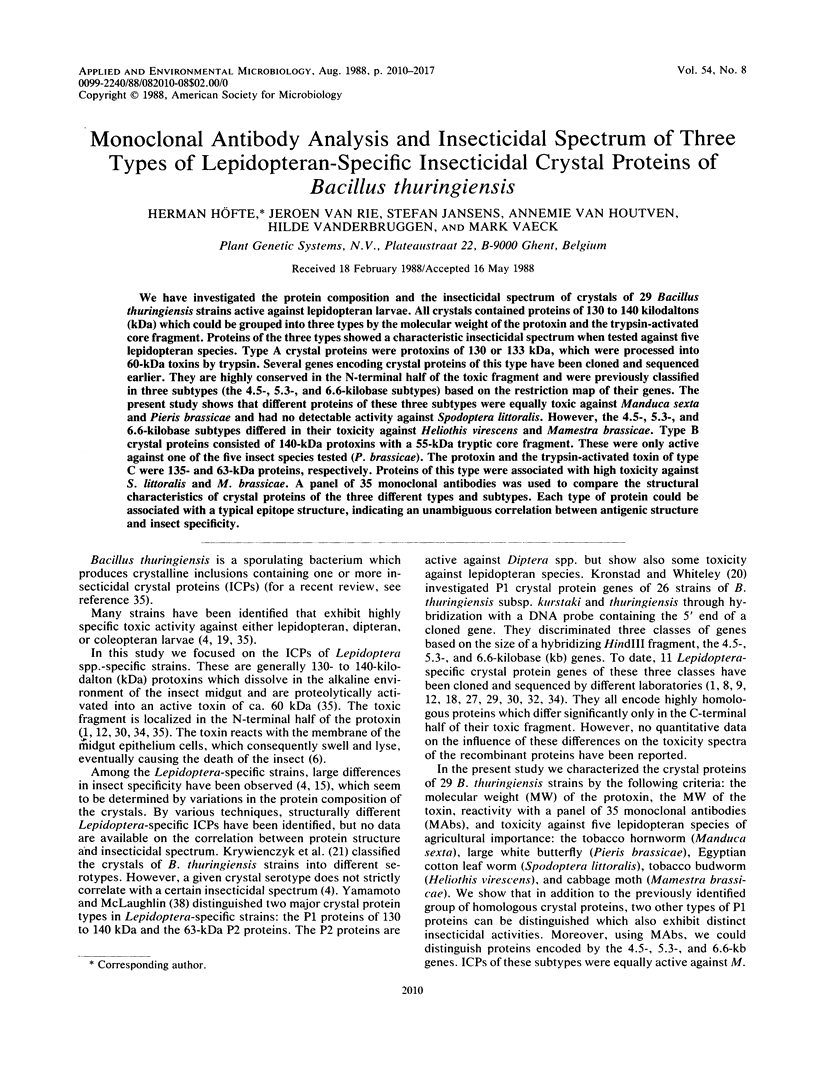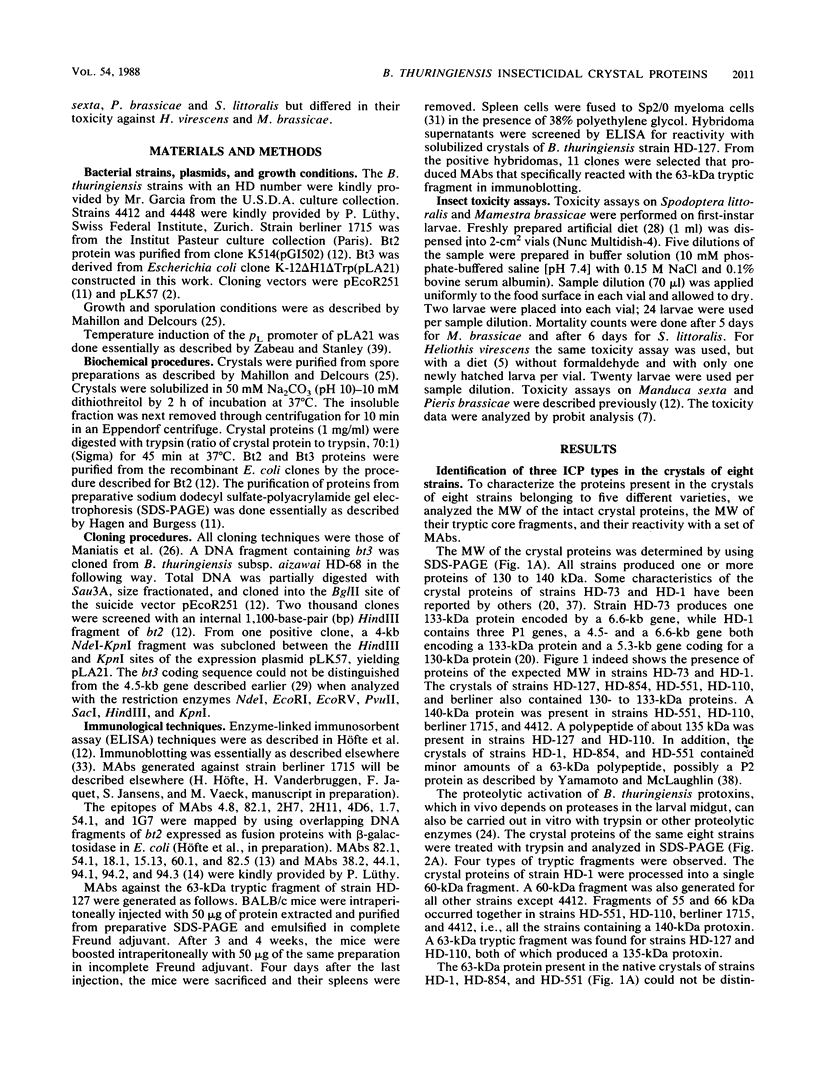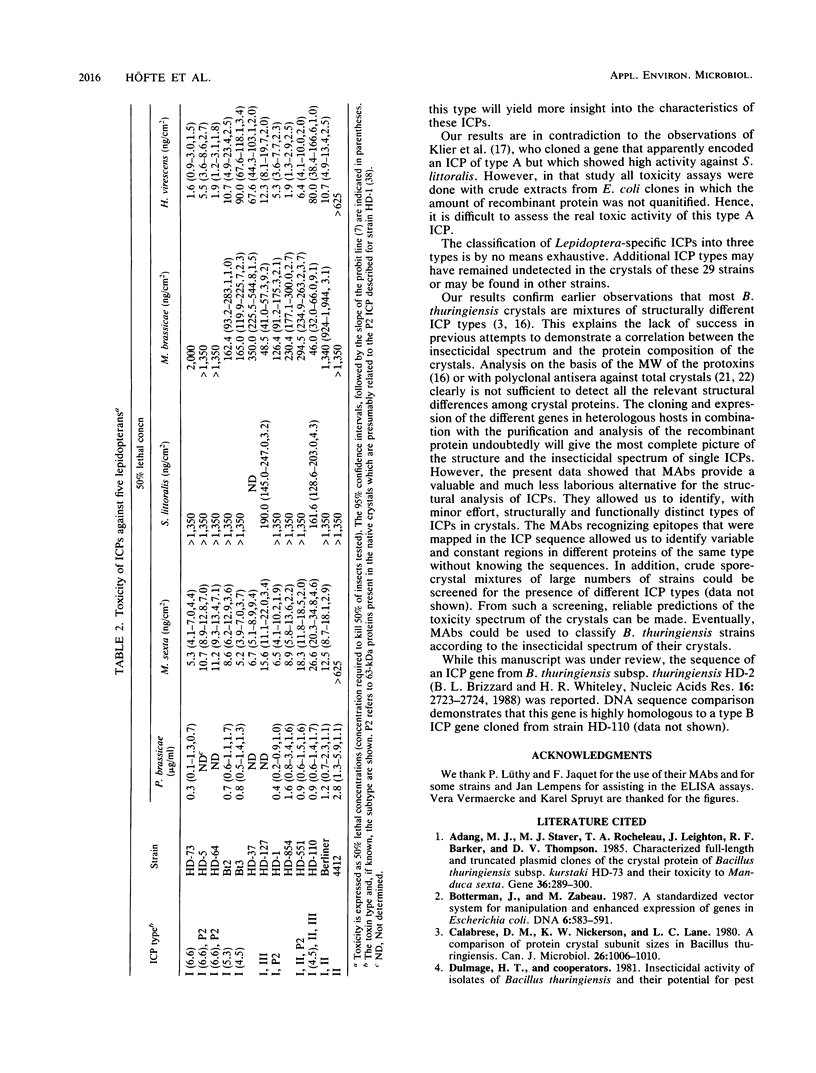Abstract
We have investigated the protein composition and the insecticidal spectrum of crystals of 29 Bacillus thuringiensis strains active against lepidopteran larvae. All crystals contained proteins of 130 to 140 kilodaltons (kDa) which could be grouped into three types by the molecular weight of the protoxin and the trypsin-activated core fragment. Proteins of the three types showed a characteristic insecticidal spectrum when tested against five lepidopteran species. Type A crystal proteins were protoxins of 130 or 133 kDa, which were processed into 60-kDa toxins by trypsin. Several genes encoding crystal proteins of this type have been cloned and sequenced earlier. They are highly conserved in the N-terminal half of the toxic fragment and were previously classified in three subtypes (the 4.5-, 5.3-, and 6.6-kilobase subtypes) based on the restriction map of their genes. The present study shows that different proteins of these three subtypes were equally toxic against Manduca sexta and Pieris brassicae and had no detectable activity against Spodoptera littoralis. However, the 4.5-, 5.3-, and 6.6-kilobase subtypes differed in their toxicity against Heliothis virescens and Mamestra brassicae. Type B crystal proteins consisted of 140-kDa protoxins with a 55-kDa tryptic core fragment. These were only active against one of the five insect species tested (P. brassicae). The protoxin and the trypsin-activated toxin of type C were 135- and 63-kDa proteins, respectively. Proteins of this type were associated with high toxicity against S. littoralis and M. brassicae. A panel of 35 monoclonal antibodies was used to compare the structural characteristics of crystal proteins of the three different types and subtypes. Each type of protein could be associated with a typical epitope structure, indicating an unambiguous correlation between antigenic structure and insect specificity.
Full text
PDF







Images in this article
Selected References
These references are in PubMed. This may not be the complete list of references from this article.
- Adang M. J., Staver M. J., Rocheleau T. A., Leighton J., Barker R. F., Thompson D. V. Characterized full-length and truncated plasmid clones of the crystal protein of Bacillus thuringiensis subsp. kurstaki HD-73 and their toxicity to Manduca sexta. Gene. 1985;36(3):289–300. doi: 10.1016/0378-1119(85)90184-2. [DOI] [PubMed] [Google Scholar]
- Botterman J., Zabeau M. A standardized vector system for manipulation and enhanced expression of genes in Escherichia coli. DNA. 1987 Dec;6(6):583–591. doi: 10.1089/dna.1987.6.583. [DOI] [PubMed] [Google Scholar]
- Brizzard B. L., Whiteley H. R. Nucleotide sequence of an additional crystal protein gene cloned from Bacillus thuringiensis subsp. thuringiensis. Nucleic Acids Res. 1988 Mar 25;16(6):2723–2724. doi: 10.1093/nar/16.6.2723. [DOI] [PMC free article] [PubMed] [Google Scholar]
- Calabrese D. M., Nickerson K. W., Lane L. C. A comparison of protein crystal subunit sizes in Bacillus thuringiensis. Can J Microbiol. 1980 Aug;26(8):1006–1010. doi: 10.1139/m80-170. [DOI] [PubMed] [Google Scholar]
- Geiser M., Schweitzer S., Grimm C. The hypervariable region in the genes coding for entomopathogenic crystal proteins of Bacillus thuringiensis: nucleotide sequence of the kurhd1 gene of subsp. kurstaki HD1. Gene. 1986;48(1):109–118. doi: 10.1016/0378-1119(86)90357-4. [DOI] [PubMed] [Google Scholar]
- González J. M., Jr, Brown B. J., Carlton B. C. Transfer of Bacillus thuringiensis plasmids coding for delta-endotoxin among strains of B. thuringiensis and B. cereus. Proc Natl Acad Sci U S A. 1982 Nov;79(22):6951–6955. doi: 10.1073/pnas.79.22.6951. [DOI] [PMC free article] [PubMed] [Google Scholar]
- Hager D. A., Burgess R. R. Elution of proteins from sodium dodecyl sulfate-polyacrylamide gels, removal of sodium dodecyl sulfate, and renaturation of enzymatic activity: results with sigma subunit of Escherichia coli RNA polymerase, wheat germ DNA topoisomerase, and other enzymes. Anal Biochem. 1980 Nov 15;109(1):76–86. doi: 10.1016/0003-2697(80)90013-5. [DOI] [PubMed] [Google Scholar]
- Huber-Lukac M., Jaquet F., Luethy P., Huetter R., Braun D. G. Characterization of monoclonal antibodies to a crystal protein of Bacillus thuringiensis subsp. kurstaki. Infect Immun. 1986 Oct;54(1):228–232. doi: 10.1128/iai.54.1.228-232.1986. [DOI] [PMC free article] [PubMed] [Google Scholar]
- Huber-Lukac M., Lüthy P., Braun D. G. Specificities of monoclonal antibodies against the activated delta-endotoxin of Bacillus thuringiensis var. thuringiensis. Infect Immun. 1983 May;40(2):608–612. doi: 10.1128/iai.40.2.608-612.1983. [DOI] [PMC free article] [PubMed] [Google Scholar]
- Höfte H., de Greve H., Seurinck J., Jansens S., Mahillon J., Ampe C., Vandekerckhove J., Vanderbruggen H., van Montagu M., Zabeau M. Structural and functional analysis of a cloned delta endotoxin of Bacillus thuringiensis berliner 1715. Eur J Biochem. 1986 Dec 1;161(2):273–280. doi: 10.1111/j.1432-1033.1986.tb10443.x. [DOI] [PubMed] [Google Scholar]
- Jaquet F., Hütter R., Lüthy P. Specificity of Bacillus thuringiensis Delta-Endotoxin. Appl Environ Microbiol. 1987 Mar;53(3):500–504. doi: 10.1128/aem.53.3.500-504.1987. [DOI] [PMC free article] [PubMed] [Google Scholar]
- Kronstad J. W., Whiteley H. R. Three classes of homologous Bacillus thuringiensis crystal-protein genes. Gene. 1986;43(1-2):29–40. doi: 10.1016/0378-1119(86)90005-3. [DOI] [PubMed] [Google Scholar]
- Krywienczyk J., Dulmage H. T., Fast P. G. Occurrence of two serologically distinct groups within Bacillus thuringiensis serotype 3 ab var. kurstaki. J Invertebr Pathol. 1978 May;31(3):372–375. doi: 10.1016/0022-2011(78)90232-x. [DOI] [PubMed] [Google Scholar]
- Lilley M., Ruffell R. N., Somerville H. J. Purification of the insecticidal toxin in crystals of Bacillus thuringiensis. J Gen Microbiol. 1980 May;118(1):1–11. doi: 10.1099/00221287-118-1-1. [DOI] [PubMed] [Google Scholar]
- Oeda K., Oshie K., Shimizu M., Nakamura K., Yamamoto H., Nakayama I., Ohkawa H. Nucleotide sequence of the insecticidal protein gene of Bacillus thuringiensis strain aizawai IPL7 and its high-level expression in Escherichia coli. Gene. 1987;53(1):113–119. doi: 10.1016/0378-1119(87)90098-9. [DOI] [PubMed] [Google Scholar]
- Schnepf H. E., Wong H. C., Whiteley H. R. The amino acid sequence of a crystal protein from Bacillus thuringiensis deduced from the DNA base sequence. J Biol Chem. 1985 May 25;260(10):6264–6272. [PubMed] [Google Scholar]
- Shibano Y., Yamagata A., Nakamura N., Iizuka T., Sugisaki H., Takanami M. Nucleotide sequence coding for the insecticidal fragment of the Bacillus thuringiensis crystal protein. Gene. 1985;34(2-3):243–251. doi: 10.1016/0378-1119(85)90133-7. [DOI] [PubMed] [Google Scholar]
- Shulman M., Wilde C. D., Köhler G. A better cell line for making hybridomas secreting specific antibodies. Nature. 1978 Nov 16;276(5685):269–270. doi: 10.1038/276269a0. [DOI] [PubMed] [Google Scholar]
- Thorne L., Garduno F., Thompson T., Decker D., Zounes M., Wild M., Walfield A. M., Pollock T. J. Structural similarity between the lepidoptera- and diptera-specific insecticidal endotoxin genes of Bacillus thuringiensis subsp. "kurstaki" and "israelensis". J Bacteriol. 1986 Jun;166(3):801–811. doi: 10.1128/jb.166.3.801-811.1986. [DOI] [PMC free article] [PubMed] [Google Scholar]
- Towbin H., Staehelin T., Gordon J. Electrophoretic transfer of proteins from polyacrylamide gels to nitrocellulose sheets: procedure and some applications. Proc Natl Acad Sci U S A. 1979 Sep;76(9):4350–4354. doi: 10.1073/pnas.76.9.4350. [DOI] [PMC free article] [PubMed] [Google Scholar]
- Wabiko H., Raymond K. C., Bulla L. A., Jr Bacillus thuringiensis entomocidal protoxin gene sequence and gene product analysis. DNA. 1986 Aug;5(4):305–314. doi: 10.1089/dna.1986.5.305. [DOI] [PubMed] [Google Scholar]
- Whiteley H. R., Schnepf H. E. The molecular biology of parasporal crystal body formation in Bacillus thuringiensis. Annu Rev Microbiol. 1986;40:549–576. doi: 10.1146/annurev.mi.40.100186.003001. [DOI] [PubMed] [Google Scholar]
- Yamamoto T., McLaughlin R. E. Isolation of a protein from the parasporal crystal of Bacillus thuringiensis var. Kurstaki toxic to the mosquito larva, Aedes taeniorhynchus. Biochem Biophys Res Commun. 1981 Nov 30;103(2):414–421. doi: 10.1016/0006-291x(81)90468-x. [DOI] [PubMed] [Google Scholar]
- Zabeau M., Stanley K. K. Enhanced expression of cro-beta-galactosidase fusion proteins under the control of the PR promoter of bacteriophage lambda. EMBO J. 1982;1(10):1217–1224. doi: 10.1002/j.1460-2075.1982.tb00016.x. [DOI] [PMC free article] [PubMed] [Google Scholar]




